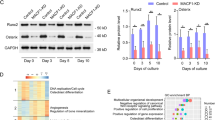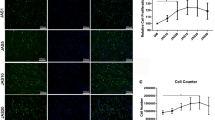Abstract
Dynamic cytoskeletal changes appear to be one of intracellular signals that control cell differentiation. To test this hypothesis, we examined the effects of short-term actin cytoskeletal changes on osteoblastic differentiation. We found an actin polymerization interfering reagent, cytochalasin D, promoted osteoblastic differentiation in mouse preosteoblastic MC3T3-E1 cells. We also found that these effects were mediated by the protein kinase D (PKD) pathway. Short-term cytochalasin D treatment increased alkaline phosphatase (ALP) activity, osteocalcin (OCN) secretion, and mineralization of the extracellular matrix in MC3T3-E1 cells, with temporary changes in actin cytoskeleton. Furthermore, the disruption of actin cytoskeleton induced phosphorylation of 744/748 serine within the activation loop of PKD in a dose-dependent manner. The protein kinase C (PKC)/PKD inhibitor Go6976 suppressed cytochalasin D-induced acceleration of osteoblastic differentiation, whereas Go6983, a specific inhibitor of conventional PKCs, did not. Involvement of PKD signaling was confirmed by using small interfering RNA to knock down PKD. In addition, another actin polymerization interfering reagent, latrunculin B, also stimulated ALP activity and OCN secretion with PKD activation. On the other hand, the present data suggested that transient dynamic actin cytoskeletal reorganization could be a novel cellular signal that directly stimulated osteoblastic differentiation.





Similar content being viewed by others
References
Huang S, Ingber DE (1999) The structural and mechanical complexity of cell-growth control. Nat Cell Biol 1:E131–E138
Boland S, Boisvieux-Ulrich E, Houcine O, Baeza-Squiban A, Pouchelet M, Schoëvaërt D, Marano F (1996) TGF beta 1 promotes actin cytoskeleton reorganization and migratory phenotype in epithelial tracheal cells in primary culture. J Cell Sci 109:2207–2219
Pavalko FM, Chen NX, Turner CH, Burr DB, Atkinson S, Hsieh YF, Qiu J, Duncan RL (1998) Fluid shear-induced mechanical signaling in MC3T3-E1 osteoblasts requires cytoskeleton–integrin interactions. Am J Physiol 275:C1591–C1601
Jamora C, Fuchs E (2002) Intercellular adhesion, signaling and the cytoskeleton. Nat Cell Biol 4:101–108
Howe AK, Juliano RL (2000) Regulation of anchorage-dependent signal transduction by protein kinase A and p21-activated kinase. Nat Cell Biol 2:593–600
Aplin AE, Juliano RL (1999) Integrin and cytoskeletal regulation of growth factor signaling to the MAP kinase pathway. J Cell Sci 112:695–706
Zeng C, Morrison AR (2001) Disruption of the actin cytoskeleton regulates cytokine-induced iNOS expression. Am J Physiol Cell Physiol 281:C932–C940
Sotiropoulos A, Gineitis D, Copeland J, Treisman R (1999) Signal-regulated activation of serum response factor is mediated by changes in actin dynamics. Cell 98:159–169
Irigoyen JP, Besseer D, Nagamine Y (1997) Cytoskeleton reorganization induces the urokinase-type plasminogen activator gene via the Ras/extracellular signal-regulated kinase (ERK) signaling pathway. J Biol Chem 272:1904–1909
Wei L, Wang L, Carson JA, Agan JE, Imanaka-Yoshida K, Schwartz RJ (2001) β1 integrin and organized actin filaments facilitates cardiomyocyte-specific RhoA-dependent activation of the skeletal α-actin promoter. FASEB J 15:785–797
Mack CP, Somlyo AV, Hautmann M, Somlyo AP, Owens GK (2001) Smooth muscle differentiation marker gene expression is regulated by RhoA-mediated actin polymerization. J Biol Chem 276:341–347
Varedi M, Ghahary A, Scott PG, Tredget EE (1997) Cytoskeleton regulates expression of genes for transforming growth factor-β1 and extracellular matrix proteins in dermal fibroblasts. J Cell Physiol 172:192–199
Miyamato S, Teramoto H, Gutkind JS, Yamada KM (1996) Integrins can collaborate with growth factors for phosphorylation of receptor tyrosine kinases and MAP kinase activation: roles of integrin aggregation and occupancy of receptors. J Cell Biol 135:1633–1642
Vinall RL, Lo SH, Reddi AH (2002) Regulation of articular chondrocyte phenotype by bone morphogenetic protein 7, interleukin 1, and cellular context is dependent on the cytoskeleton. Exp Cell Res 272:32–44
Zhang A, Messana J, Hwang NS, Elisseeff JH (2006) Reorganization of actin filaments enhances chondrogenic differentiation of cells derived from murine embryonic stem cells. Biochem Biophys Res Commun 348:421–427
Lim YB, Kang SS, Park TK, Lee YS, Chun JS, Sonn JK (2000) Disruption of actin cytoskeleton induces chondrogenesis of mesenchymal cells by activating protein kinase C-α signaling. Biochem Biophy Res Commun 273:609–613
Favus MJ, Christakos S, Kaplan FS, Shane E, Robey PG, Khosla S, Shoback DM, Kleerekoper M, Goldring SR, Langman CB, Stewart AF, Holick MF, Lian JB, Whyte MP (1999) Primer on the metabolic bone diseases and disorders of mineral metabolism, 4th edn. Lippincott Williams and Wilkins, Philadelphia
Reddi AH (1997) Actions in flesh and bone. Nat Med 3:837–839
Canalis E, Delany A (2002) Mechanisms of glucocorticoid action in bone. Ann N Y Acad Sci 966:73–81
Ehrlich PJ, Lanyon LE (2002) Mechanical strain and bone cell function: a review. Osteoporos Int 13:688–700
Matsuda N, Morita N, Matsuda K, Watanabe M (1998) Proliferation and differentiation of human osteoblastic cells associated with differential activation of MAP kinases in response to epidermal growth factor, hypoxia, and mechanical stress in vitro. Biochem Biophys Res Commun 249:350–354
Hillam RA, Skerry TM (1995) Inhibition of bone resorption of formation by mechanical loading of the modeling ret ulna in vivo. J Bone Miner Res 10:683–689
Gschwendt M, Johannes FJ, Kittstein W, Marks F (1997) Regulation of protein kinase C mu by basic peptides and heparin. Putative role of an acidic domain in the activation of the kinase. J Biol Chem 272:20742–20746
Lint JV, Rykx A, Vantus T, Vandenheede JR (2002) Getting to know protein kinase D. Int J Biochem Cell Biol 34:577–581
Van Lint J, Rykx A, Maeda Y, Vantus T, Sturany S, Malhotra V, Vandenheede JR, Seufferlein T (2002) Protein kinase D: an intracellular traffic regulator on the move. Trends Cell Biol 12:193–200
Rykx A, De Kimpe L, Mikhalap S, Vantus T, Seufferlein T, Vandenheede JR, Van Lint J (2003) Protein kinase D: a family affair. FEBS Lett 546:81–86
Prestle J, Pfizenmaier K, Brenner J, Johannes FJ (1996) Protein kinase C mu is located at the Golgi compartment. J Cell Biol 134:1401–1410
Jamora C, Yamanouye N, Van Lint J, Laudenslager J, Vandenheede JR, Faulkner DJ, Malhotra V (1999) Gbetagamma-mediated regulation of Golgi organization is through the direct activation of protein kinase D. Cell 98:59–68
Johannes FJ, Horn J, Link G, Haas E, Siemienski K, Wajant H, Pfizenmaier K (1998) Protein kinase C mu downregulation of tumor-necrosis-factor-induced apoptosis correlates with enhanced expression of nuclear-factor-kappa B-dependent protective genes. Eur J Biochem 257:47–54
Lemonnier J, Ghayor C, Guicheux J, Caverzasio J (2004) Protein kinase C-independent activation of protein kinase D is involved in BMP-2-induced activation of stress mitogen-activated protein kinases JNK and p38 and osteoblastic cell differentiation. J Biol Chem 279:259–264
Higuchi C, Myoui A, Hashimoto N, Kuriyama K, Yoshioka K, Yoshikawa H, Itoh K (2002) Continuous inhibition of MAPK signalling promotes the early osteoblastic differentiation and mineralization of the extracellular matrix. J Bone Miner Res 17:1785–1794
Iwasaki M, Nakahara H, Nakase T, Kimura T, Takaoka K, Caplan AI, Ono K (1994) Bone morphogenetic protein 2 stimulates osteogenesis but does not affect chondrogenesis in osteochondrogenic differentiation of periosteum-derived cells. J Bone Miner Res 9:1195–1204
Kusumi T, Nishi T, Tanaka M, Tsuchida S, Kudo H (2001) A murine osteosarcoma cell line with a potential to develop ossification upon transplantation. Jpn J Cancer Res 92:649–658
Marzia M, Sims NA, Voit S, Migliaccio S, Taranta A, Bernardini S, Faraggiana T, Yoneda T, Mundy GR, Boyce BF, Baron R, Teti A (2000) Decreased c-Src expression enhances osteoblast differentiation and bone formation. J Cell Biol 151:311–320
Laemmli UK (1970) Cleavage of structural protein during the assembly of the head of bacteriophage. Nature 227:680–685
Kapur S, Baylink DJ, Lau KHW (2003) Fluid flow shear stress stimulates human osteoblast proliferation and differentiation through multiple interacting and competing signal transduction pathways. Bone 32:241–251
Akhouayri O, Lafage-Proust MH, Rattner A, Laroche N, Caillot-Augusseau A, Alexandre C, Vico L (1999) Effects of static or dynamic mechanical stresses on osteoblast phenotype expression in three-dimensional contractile collagen gels. J Cell Biochem 76:217–230
Chen NX, Ryder KD, Pavalko FM, Turner CH, Burr DB, Oiu J, Duncan RL (2000) Ca2+ regulates fluid shear-induced cytoskeletal reorganization and gene expression in osteoblasts. Am J Physiol Cell Physiol 278:C989–C997
Katagiri T, Yamaguchi A, Komaki M, Abe E, Takahashi N, Ikeda T, Rosen V, Wozney JM, Fujisawa-Sehara A, Suda T (1994) Bone morphogenetic protein-2 converts the differentiation pathway of C2C12 myoblasts into the osteoblastic lineage. J Cell Biol 127:1755–1766
Arber S, Barbayannis FA, Hanser H, Schneider C, Stanyon CA, Bernard O, Caroni P (1998) Regulation of actin dynamics through phosphorylation of cofilin by LIM-kinase. Nature 393:805–812
Yang N, Higuchi O, Ohashi K, Nagata K, Wada A, Kangawa K, Nishida E, Mizuno K (1998) Cofilin phosphorylation by LIM-kinase 1 and its role in Rac-mediated actin reorganization. Nature 393:809–812
Celil AB, Campbell PG (2005) BMP-2 and insulin-like growth factor-I mediate Osterix (Osx) expression in human mesenchymal stem cells via the MAPK and protein kinase D signaling pathways. J Biol Chem 280:31353–31359
Morton WM, Ayscough KR, McLaughlin PJ (2000) Latrunculin alters the actin-monomer subunit interface to prevent polymerization. Nat Cell Biol 2:376–378
Cooper JA (1987) Effects of cytochalacin and phalloidin on actin. J Cell Biol 105:1473–1478
Geng WD, Boskovic G, Fultz ME, Li C, Niles RM, Ohno S, Wright GL (2001) Regulation of expression and activity of four PKC isozyme in confluent and mechanically stimulated UMR-108 osteoblastic cells. J Cell Physiol 189:216–228
Toma CD, Ashkar S, Gray ML, Schaffer JL, Gerstenfeld LC (1997) Signal transduction of mechanical stimuli is dependent on microfilament integrity: identification of osteopontin as a mechanically induced gene in osteoblasts. J Bone Miner Res 12:1626–1636
Acknowledgments
We are grateful to Dr. Kiyoko Yoshioka for her valuable discussions and her assistance. This study was supported in part by research grants from the Ministry of Health, Labour and Welfare of Japan as well as by research grants from Takeda Science Foundation.
Author information
Authors and Affiliations
Corresponding author
Electronic supplementary material
Below is the link to the electronic supplementary material.
About this article
Cite this article
Higuchi, C., Nakamura, N., Yoshikawa, H. et al. Transient dynamic actin cytoskeletal change stimulates the osteoblastic differentiation. J Bone Miner Metab 27, 158–167 (2009). https://doi.org/10.1007/s00774-009-0037-y
Received:
Accepted:
Published:
Issue Date:
DOI: https://doi.org/10.1007/s00774-009-0037-y




